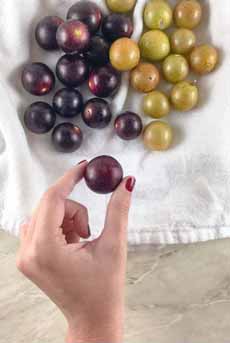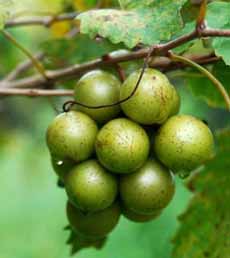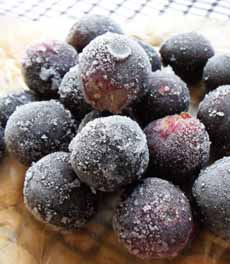TIP OF THE DAY: Muscadine Grapes
|
What are those jumbo grapes you occasionally find in the market? They’re muscadine grapes, Vitis rotundifolia, a species native to the warm, humid climate of the southeastern and south-central United States. The vines are well adapted to their native warm and humid climate. The grape has been extensively cultivated since the 16th century. Today there are more than 300 muscadine cultivars grown in the U.S. When ripe, the different varieties are green, bronze, red or black. Today’s crops include common (natural) grapes and patented grapes, which are hybrids bred (and patented) to enhance qualities. Like other grapes, muscadines are a rich source of polyphenols, powerful antioxidants. Muscadines naturally have thicker skin, so the fruit was not popular as a table grape. Instead, the variety was, and is, typically used in making jelly, juice and wine. Modern breeding of patent grapes has made the skin readily palatable, and it is these grapes that have sprung up in food markets in the last few years. Food Trivia: Fans of older novels may have come across characters drinking scuppernong wine. It is a dry red table wine made from the bronze variety of muscadine. In the South, bronze muscadine grapes are called scuppernong, after the Scuppernong River in North Carolina, where they were originally bred. The other colors are called muscadine. You can use muscadines anywhere you use other grapes, although in situations requiring a fork, you may need to cut them in half to spear them. While immigrants brought their own varieties from Europe (known as Old World grapes), America had a ready supply of indigenous grapes. Native to eastern North America, the wild vines of Vitis labrusca were first cultivated in the mid-19th century in Concord, Massachusetts, by crossbreeding them with the common European wine grape Vitis vinifera. Concord grapes have a sweet, candy-like flavor and a “foxy” aroma. They’re the flavor Americans think of as “grapey”. What’s “foxy?” The term refers to a distinctive note found in some wines: a sort of wild, musky, animal aroma. The grapes are often called “fox grapes.” The aroma is unusual, but not unpleasant. One wine writer commented that it reminds him of the scent of a fur coat. The quality is often found in American grape varieties like Concord or Catawba, and the aroma of the wine is usually accompanied by a grapey flavor. Concord grapes are known to most Americans as the grape used to make grape jelly and purple grape juice. They are the most common source of the grape flavoring in candies and sodas. Concord grapes are also used to make sweet wines. Their deep purple color makes them a popular choice for sacramental wines and Kosher wines. |
 [1] Perhaps the largest cultivated grape you’ll find (photo courtesy Sid Wainer).
|
|
|
Another note of interest: The variety also has slip skins, meaning that the skin slides freely off the ripe grape when squeezed. Catawba Grapes Other cultivars of the species Vitis labrusca are used to make dry wines. Before the Concord grape became prominent, Catawba was the most planted grape in early 19th-century America. It was and is used to make white and rosé sparkling wines, as well as juice, jams and jellies. Isabella is another cultivar derived from Vitis labrusca. It is used as a table grape, and to make juice and wine. A dark grape originating in the southern United States, it has spread around the world. It is widely planted in South America, and is one of the most popular grapes in the former USSR, grown in Azerbaijan, Georgia and Moldova, used to make dry red wines.
|
||





